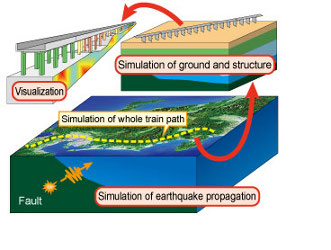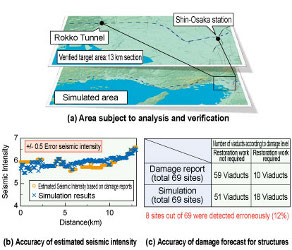2. Seismic Hazard simulator for railways
A simulator was developed to identify locations which were vulnerable to earthquakes on the railway network (Figure 1). Data regarding the fault, ground and structures were collected into a database. By using the data, the simulator constructed numerical analysis models of the fault, ground, and structure, in order to evaluate the seismic response of the ground and structures. Information about damage obtained through analysis of the data was then linked to map information, in order to allow visualization of structural damage in disaster hit areas.
The simulator selects the most appropriate analytical model depending on the type and volume of data. When detailed data is available, a three-dimensional FEM model for the area from the fault to the bedrock, a two-dimensional FEM model for the surface subsoil and a three-dimensional skeletal frame model for the structure are used. This method provides a seismic response analysis of an accuracy which satisfies design calculation requirements.
Accuracy of the method was also tested by comparing estimations with data from the 1995 South Hyogo Earthquake, and evaluating the seismic response and damage to structures over a 13 km stretch where damage was particularly severe (Figure 2 (a)). The structures examined were 69 viaducts. Seismic intensity evaluated using the simulator gave estimations accurate to within a margin of ± 0.5 with measured data (Figure 2 (b)).
Accuracy of structural damage evaluation, in terms of identifying those structures which require restoration, produced results with an error margin of approximately 12% (still within safety side assessment) (Figure 2 (c)).
These results indicate that the method is precise enough to detect vulnerable spots on the railway network.
With the prospect of the forecast large-scale earthquake directly beneath Tokyo, and a Nankai – Tonankai Earthquake, it is important to be able to plan seismic reinforcement work, and construct recovery scenarios. This simulator should serve as a supporting tool in this regard.
Other Contents
- 1. Seismic ground motion simulator applicable to M9 earthquakes
- 2. Seismic Hazard simulator for railways
- 3. Early warning system employing ocean bottom seismometer data
- 4. Development of Railway Embankment Structures Resistant to severe Earthquakes and Prolonged Overflows caused by Tsunamis
- 5. Measures against buckling of ballasted track during earthquakes
- 6. Disaster Hazard Mapping Technology
- 7. Method for diagnosing condition of concrete roadbed in tunnels
- 8. Analytical method for evaluating carbody safety aimed at reducing passenger injury in case of level crossing collisions
- 9. Bogie to control decrement in wheel load
- 10. Mechanical pneumatic steering system with failsafe function
- 11. Gear oil for Shinkansen trains with improved startability in low temperature conditions
- 12. Process to select appropriate sounds to convey in-cab driver alerts
- 13. Training in communication techniques for train dispatchers in disrupted situations
- 1. Seismic ground motion simulator applicable to M9 earthquakes
- 2. Seismic Hazard simulator for railways
- 3. Early warning system employing ocean bottom seismometer data
- 4. Development of Railway Embankment Structures Resistant to severe Earthquakes and Prolonged Overflows caused by Tsunamis
- 5. Measures against buckling of ballasted track during earthquakes
- 6. Disaster Hazard Mapping Technology
- 7. Method for diagnosing condition of concrete roadbed in tunnels
- 8. Analytical method for evaluating carbody safety aimed at reducing passenger injury in case of level crossing collisions
- 9. Bogie to control decrement in wheel load
- 10. Mechanical pneumatic steering system with failsafe function
- 11. Gear oil for Shinkansen trains with improved startability in low temperature conditions
- 12. Process to select appropriate sounds to convey in-cab driver alerts
- 13. Training in communication techniques for train dispatchers in disrupted situations


